Blagdon Lake Birds
July 2021 News
Saturday 31st July
Mark spent much of the afternoon and evening at the lake, and I met him when I went down later. He'd seen 3 Little Egrets Egretta garzetta, 3+ Lapwings Vanellus vanellus at Rugmoor, and a juvenile Peregrine Falco peregrinus bearing a blue ring on its left leg that he couldn't read, unfortunately. I saw the 2 Egyptian Geese Alopochen aegyptiaca on the dam, and we both saw 2 Great White Egrets Ardea alba and a number of Swifts Apus apus.
Friday 30th July
I made a flying visit to recover the mobile phone I Ieft on the table in front of the Lodge last night in all the rain - doh! I saw 2 Egyptian Geese Alopochen aegyptiaca on the dam while I was there.
Thursday 29th July [Dry & warm]
Only time for an evening walk again today, but there was the welcome sight of the island peeking above the surface in front of the Lodge known as Tiny's Shallow, which, if it continues to get exposed, will be an undoubted draw for passage waders we hope. There was an adult Redshank Tringa totanus at Polish water in front of the Lodge, 2 Egyptian Geese Alopochen aegyptiaca and a Common Sandpiper Actitis hypoleucos on the dam, and a Great White Egret Ardea alba at Rainbow Point, but maybe, just maybe, there might be some passage birds brought down by Storm Evert tonight, so an early morning visit is on the cards tomorrow. Best bird was a Lesser Whitethroat Curruca curruca at Lodge Copse the first report of the year at the lake!
Wednesday 28th July [More heavy showers with sunny intervals]
Not much to report from this evening's walk. The 2 Egyptian Geese Alopochen aegyptiaca were on the dam still, and there was a huge flock of 500+ Jackdaws Coloeus monedula and Rooks Corvus frugilegus gathering at dusk making for quite an aerial spectacle.
Tuesday 27th July [Warm with heavy showers]
Not too much to report from the lake today with the 2 Egyptian Geese Alopochen aegyptiaca on the dam, 2 Lapwings Vanellus vanellus at Holt Bay, and a Great White Egret Ardea alba on Wookey Point. Late in the evening, a small flock of 8-10 Sand Martins Riparia riparia flew through to the west in front of the Lodge.
I collected a bat that was hanging up in the open this afternoon, a juvenile Soprano Pipistrelle Pipistrellus pygmaeus, that I re-hydrated and fed before returning it to the roost just before the evening emergence. Hopefully, that will be the last of the call-outs for this breeding season.
Monday 26th July [Warm & dry]
Phil, Rob and I did the WeBS count this morning:
Water level approx. 70%
Coot 880, Tufted Duck 466, Mallard 269, Canada Goose 176, Mute Swan 60, Moorhen 57, Common Sandpiper 1, Egyptian Goose 2, Sparrowhawk 1, Buzzard 2, Kestrel 1, Marsh Harrier 1 (probably 2), Teal 3, Little Egret 3, Great White Egret 2, Mediterranean Gull 1 Juvenile, Black-headed Gull 57 adults and 27 juveniles on the dam as a sample count, Lesser Black-backed Gull 4, Great Black-backed Gull 3, Gadwall 18, Pochard 3, Cormorant 11, Grey Heron 8, Lapwing 1.
We saw the usual female Marsh Harrier (same as present part of last year with a white primary) that is chocolate brown with a golden crown (brown feathering admixed) and a hint of the same on the leading edges of the wings), but a second bird was also seen briefly that was altogether different in colouration and more puzzling. I'm going back in a few minutes to look for it, even though it might be a bit late in the day.
Sunday 25th July [Cooler but still warm]
As usual, there was a Common Sandpiper Actitis hypoleucos at Cheddar Water, with our first Black-tailed Godwit Limosa limosa of the year at the Lodge, and a female Marsh Harrier Circus aeruginosus, a Great White Egret Ardea alba and 2 Little Egrets Egretta garzetta at Rugmoor.
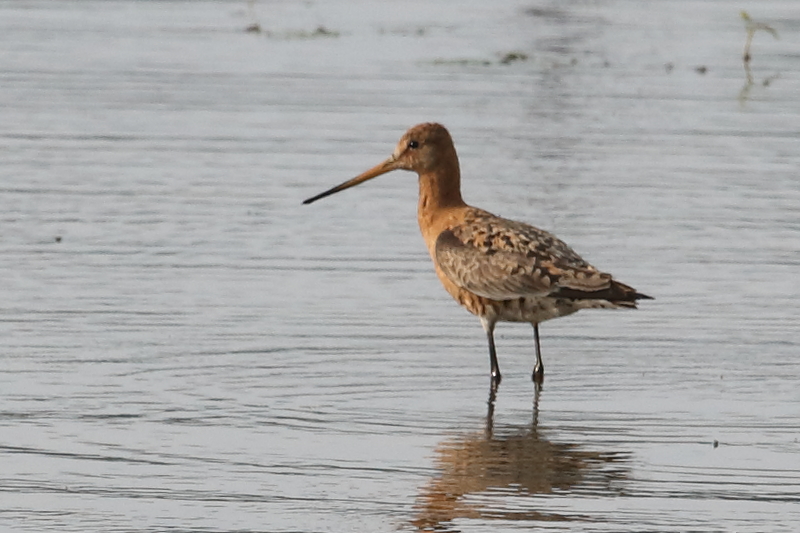
Saturday 24th July [Overnight thunderstorms & rain]
I was hoping for some new birds today, but my visit was a little disappointing from that point of view. I saw 3 Little Egrets Egretta garzetta, 2 Common Sandpipers Actitis hypoleucos, 2 Egyptian Geese Alopochen aegyptiaca, 9 Lapwings Vanellus vanellus, and a Hobby Falco subbuteo. Mark and I checked a roost that has been empty all year and saw 2 Lesser Horseshoe Bats Rhinolophus hipposideros at home as well.
Mark has sent me some photos of the South African Shelduck and an ovipositing female Emperor Dragonfly taken last Wednesday, plus one taken with Daniel Hargreaves lakeside at the end of June:
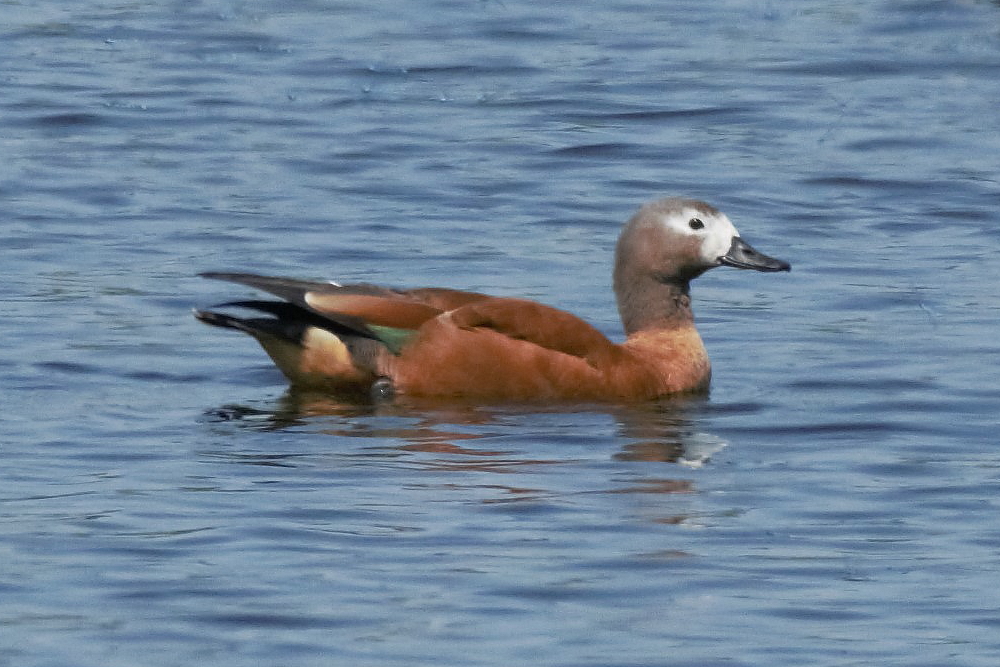
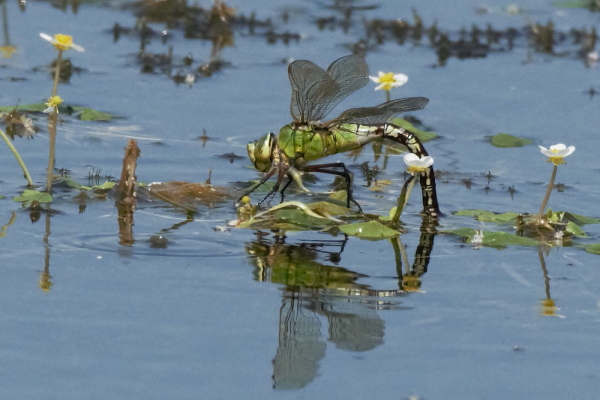
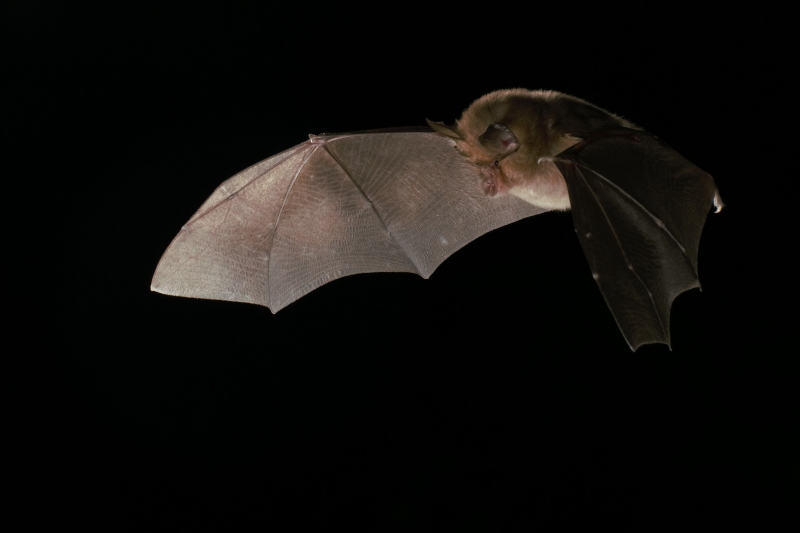
Friday 23rd July [Hot with a pleasant easterly breeze]
I only saw the one Common Sandpiper Actitis hypoleucos at Cheddar Water today, with a Little Egret Egretta garzetta at Green Lawn, and 2 Lapwings Vanellus vanellus visible on Rugmoor Point. I finally saw the Great Crested Grebe Podiceps cristatus pair that nested at the Lodge with two juveniles, my first sighting since 13th July, but it's good they've been keeping hidden away from predators. They are the only successful pair this year.
I collected, checked, fed and re-hydrated two juvenile Soprano Pipistrelles Pipistrellus pygmaeus this afternoon, and returned them to the roost this evening where I hope they were reunited with their respective mothers.
Thursday 22nd July [Scorchio]
I had a walk in the evening and saw a Common Sandpiper Actitis hypoleucos and 2 Egyptian Geese Alopochen aegyptiaca on the dam, 2 Little Egrets Egretta garzetta at Green Lawn and another at Flower Corner, a Hobby Falco subbuteo, a Fox Vulpes vulpes, and fisheries ranger Pete told me he'd seen a Leveret Lepus europaeus.
Mark is going to let me have a couple of shots he took yesterday while we were out, so I'll spare you my record shot of the South African Shelduck taken with a 180 mm macro lens! I didn't see or hear it this evening, but I did see a wader through my bins across the other side in Rugmoor Bay, that Mark went to look for on his way down. Alas, he couldn't find it, although while we were standing on the dam at dusk looking for bats, he thought he heard a Redshank calling, but couldn't be sure, so sadly its another one that got away. However, I did see a Tawny Owl Strix aluco that flew from Butcombe Bank towards the Pumping Station, in the light of the rising moon. A fine way to end the day.
Wednesday 21st July [Still scorchio]
An interesting day that kicked off with a call-out for a bat at 0612 hrs. It was later returned to the maternity roost after re-hydration. Mark, Ken and I also counted the roost in the evening while we were there, and it was another large Soprano Pipistrelle Pipistrellus pygmaeus roost of more than 300 bats, previously counted at 170. The extra numbers are no doubt down to youngsters now on the wing.
After breakfast I went down to the lake with my 180 mm macro lens hoping to find the probable Vagrant Emperor seen briefly last night. Unfortunately, even though I was joined by Mark for much of the day we couldn't spot it again. We did, however, find some Small Red-eyed Damselflies Erythromma viridulum at Green Lawn, a male Roesel's Bush-cricket Roeseliana roeselii at Long Bay, a female South African (aka Cape) Shelduck Tadorna cana (another one for the growing category E list), a Red Kite Milvus milvus, a female Marsh Harrier Circus aeruginosus, 3 Little Egrets Egretta garzetta, 7 Lapwings Vanellus vanellus, a Common Sandpiper Actitis hypoleucos, the first returning Teal Anas crecca, and a number of 6-spot Burnet Moths Zygaena filipendulae. Sadly, for the moths and many of the insects, the hay cut has begun at the Top End and gone along the south side as far as Burmah Road so far.
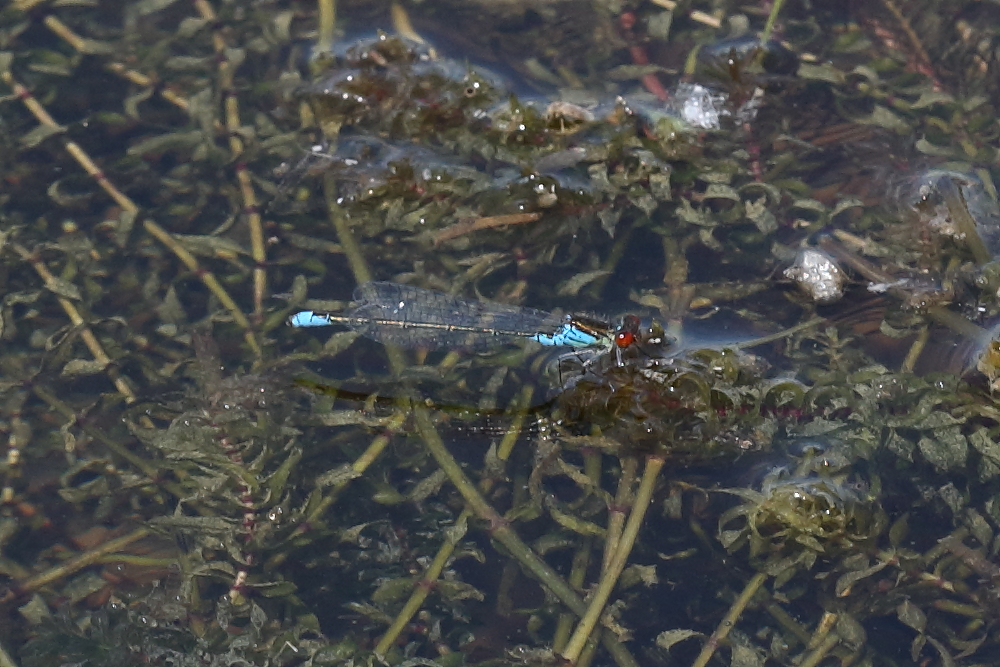
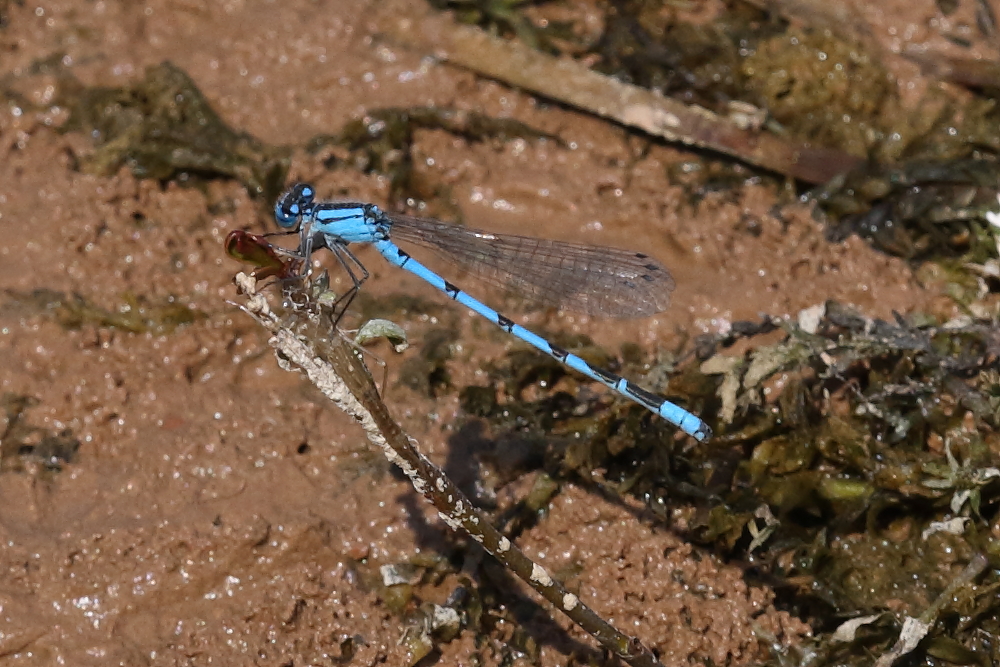
Tuesday 20th July [Muy scorchio]
Mark and I had a look around the lake this evening and saw 2 Common Sandpipers Actitis hypoleucos and 2 Egyptian Geese Alopochen aegyptiaca on the dam, Mark spotted a Green Sandpiper Tringa ochropus on Rugmoor Point, where there were also at least 2 Lapwings Vanellus vanellus, 2 Little Egrets Egretta garzetta and a Great White Egret Ardea alba. We spent some time looking for what I'm sure was a Vagrant Emperor dragonfly that I saw briefly hanging up in a hedge, but only found lots of Emperors Anax imperator and a Four-spotted Chaser Libellula quadrimaculata (a rare site record). All things being equal, we will have another look for the vagrant tomorrow.
We went up into the village at dusk to count a Soprano Pipistrelle Pipistrellus pygmaeus roost, that had at least 550 animals in it - I counted 505, and then a whole load more came out as we were packing up!
Monday 19th July [Scorchio]
It was so hot this afternoon I seriously considered whether I would go for a walk this evening. Anyway, I did, and although it turned into something of a dawdle, I saw a Common Sandpiper Actitis hypoleucos and 2 Egyptian Geese Alopochen aegyptiaca on the dam wall and had a bit of a look through the Tufted Ducks Aythya fuligula. As yesterday, there was one Great White Ardea alba and 3 Little Egrets Egretta garzetta, but the Lapwings seem to have moved on.
With conditions as they are, there were no anglers on or around the lake, and the weed growth is pretty extensive again this year. But there was a flock of House Martins Delichon urbicum feeding tight over 'the boils' just off the dam wall, so something was obviously attracting them into a feeding frenzy.
Sunday 18th July [Scorchio]
With the settled weather over this part of the country you would expect that the first migrants returning south would have ideal conditions for their journeys and that most would just pass over, however, there were signs of that bird movement at the lake today, with at least 13 Lapwings Vanellus vanellus dropping in (Mark thought there might have been more), an Oystercatcher Haematopus ostralegus flying west down the lake calling at dusk, and about 240 Tufted Ducks Aythya fuligula on the water. Also noted were 2 Common Sandpipers Actitis hypoleucos, 3 Little Egrets Egretta garzetta (that stayed to roost), and a Great White Egret (non-breeding plumage) that flew off towards Chew at dusk.
Saturday 17th July [Sizzling]
I waited until the early evening before going for a walk because it was just too hot. I'm glad I did, I saw 2 Black Terns Chlidonius niger, a Great White Egret Ardea alba, 2 Little Egrets Egretta garzetta, and 2 Common Sandpipers Actitis hypoleucos.
Friday 16th July [Warm]
More bat-related work today that resulted in two juvenile bats being returned to their roosts. Mark, Ken and I counted an emergence from a local church of 379 Soprano Pipistrelles, a Myotis sp. and a Serotine in the evening!
Thursday 15th July [Warm]
More bat-related work today that resulted in five happy juvenile bats being returned to their maternity roosts. Mike Moxon sent me an email to tell me he'd seen a family of Grey Wagtails Motacilla cinerea on the Spillway - thanks Mike.
Wednesday 14th July [Warm]
I had two bat-related calls today, so had little time to go for a walk or do any birding.
Tuesday 13th July [Overcast & warm]
I had a daytime walk today and saw a Common Sandpiper Actitis hypoleucos and 2 Egyptian Geese Alopochen aegyptiaca on the dam, and heard a Reed Warbler Acrocephalus scirpaceus singing from the marginal vegetation in the southwest corner of the dam for the first time. At the Lodge the Great Crested Grebe Podiceps cristatus that's been sitting tight for the last few weeks has finally got chicks, but she was keeping them very well hidden. There was a Comma Polygonia c-album butterfly on an Ash tree at Long Bay, Scarlet Pimpernel Anagallis arvensis in flower on the foreshore at Green Lawn and a Little Egret Egretta garzetta at Rainbow Point.
Monday 12th July [Dry & mainly overcast]
I had a look for Small Red-eyed Damselflies at the boat quay late afternoon, without finding any, but did see 2 Egyptian Geese Alopochen aegyptiaca on the dam and the first returning Lapwing Vanellus vanellus on Rugmoor Point, while I was there. I went back for a walk in the evening and noted that there were probably over 100 Black-headed Gulls Chroicocephalus ridibundus present, and a steady passage of large gulls through to the west. The most interesting thing during the evening walk was coming across the two moles I found on the road on Saturday - both had some newly turned earth beside them, and when I looked closely, they were both moving!! Quite spooky... Anyway, I instantly knew what was afoot - they were being buried by Sexton Beetles. If you know nothing about, or haven't come across these creatures, have a look at the link - they are amazing, and part of the rich tapestry of life, and death. The species on the moles were red and black, but I didn't want to disturb them in their work in order to identify them to species.
Sunday 11th July [ A dry morning but turning increasingly wet.]
Mark and I met mid-morning at the lake, but not before I'd seen 3 Ravens Corvus corax fly north over the Lodge and saw a Spotted Flycatcher Muscicapa striata at Lodge Copse. Mark came to see the 'Spoffle' but dipped again, however, while we were looking, he saw 2 Stoats Mustela erminea run along a log between us, just a few feet away (and behind my back), which made his day. I saw my first 6-spot Burnet Moth Zygaena filipendulae of the year, a new family of Coots Fulica atra at Long Bay, a Little Egret Egretta garzetta at Rainbow Point, 5 Pochards Aythya ferina at Burmah Road, and a Hobby Falco subbuteo at Top End. Mark had a look in the Top End hide for bat droppings and food remains and found proof that a Greater Horseshoe Rhinolophus ferrumequinum had been using the hide as a night roost to eat and digest food. There were lots of Crane fly Tipuloidea legs, and a pair of Poplar Hawk-moth Laothoe populi wings under its perch - now that would have been a mouthful!
Saturday 10th July [Wet, so far.]
I just had a look at the BBRC work-in-progress file that was published in June, and it shows my Little Bittern record from 17th May 2020 as being accepted - yay! The only other record for the lake was in 1916...
The Common Sandpiper Actitis hypoleucos was on the dam as usual, and there was another on Green Lawn when I got there, along with 2 juvenile Black-headed Gulls Chroicocephalus ridibundus. Later, I saw a Little Egret Egretta garzetta at Rugmoor Bay, and found two dead Moles Talpa europaea on the road with no apparent injuries within a few feet of each other. I moved them to the side of the road.
Friday 9th July [Dry and warm, although overcast.]
I walked at the lake in the evening and saw the Common Sandpiper Actitis hypoleucos, 2 Little Egrets Egretta garzetta and 2 Egyptian Geese Alopochen aegyptiaca, before meeting up with Mark and Ken who had another go at videoing the bat emergence from our hibernation boxes. The first bats were out at 2041 hrs, or 45 mins before sunset, which accounts for why we missed the start of the emergence last week. Anyway, scores on the doors this week were: 21 Soprano Pipistrelles Pipistrellus pygmaeus out of H1 and 70 out of H2, both counts being down on last week, rather surprisingly.
Thursday 8th July
I walked along the lakeside in the early evening on my way to Chew Valley Lake where Ken, Mark and I did a bat roost count. I saw a Common Sandpiper Actitis hypoleucos at Cheddar Water and the 2 Egyptian Geese Alopochen aegyptiaca on the dam.
Wednesday 7th July [Some heavy showers]
Another evening walk that kicked off with a Kingfisher Alcedo atthis in flight at the dam, where there were 2 Egyptian Geese Alopochen aegyptiaca and 2 Common Sandpipers Actitis hypoleucos. There wasn't much else to report so I counted 57 (inc. 12 juvs.) Mute Swans Cygnus olor and saw a pair of Coots Fulica atra with 2 new juvs. at Wood Bay.
Tuesday 6th July [Windy]
Apologies for the lack of news recently, I've just bought a new laptop to replace the one that has been giving me so much trouble over the last year and had all my data (nearly) transferred by Jack and Maz at MiTech - a top team! Hopefully, I will be able to bring you the news and the usual regular updates again from now on.
Monday 5th July [Dry & warm, then rain at teatime.]
The only notable sightings in the evening, during a quick drive through in the rain, was a Black-headed Gull Chroicocephalus ridibundus and 2 Pochards Aythya ferina at Top End.
Sunday 4th July [Heavy thundery showers]
I was busy all day but found time and a clear spell between showers to visit the lake in the evening, during which I saw 15 Black-headed Gulls Chroicocephalus ridibundus on the dam (no juveniles yet), 49 Tufted Ducks Aythya fuligula, 100+ Herring Gulls Larus argentatus, 176 Canada Geese Branta canadensis, 5 Gadwall Mareca strepera, and a Little Egret Egretta garzetta.
Friday 2nd July
I spent much of the day with Ken Anstey at Chew Valley Lake checking and rehanging bat boxes that need some tlc. While we were at Moreton Lane, I stopped under a couple of Lime trees to point out the incredible attraction they have to bees that I'd noted at Blagdon recently, and as we stood there, we became aware of a movement of Long-tailed Tits Aegithalos caudatus along the hedge and through the trees. I counted 33, but there were no less than 40, and probably nearer 50 moving together - I only started counting when I became aware of the numbers involved. Amazing! Back at Blagdon Lake in the evening, I saw a Common Sandpiper Actitis hypoleucos at Cheddar Water, and a Great White Egret Ardea alba (in non-breeding plumage) at Holt Bay. Then, I met Mark, and he videoed the emergence of Soprano Pipistrelles Pipistrellus pygmaeus from our two hibernation boxes. Unfortunately, they were out very early, and he missed the start of the emergence, but he still counted 35 out of H1 and 88 out of H2, before packing up as rain set in - perhaps the bats knew the rain was coming?
Thursday 1st July [Dry, muggy, then breezy.]
Just the one Common Sandpiper Actitis hypoleucos at Cheddar Water today, and I was delighted to see 3 Brown Hares Lepus europaeus early in my walk. I saw Lady's Bedstraw Galium verum in flower at Holt Bay, and a Ringlet Aphantopus hyperantus butterfly at Burmah Road, both firsts for the year, and at Top End I saw a Crow Corvus corone family with 2 juveniles, a Green Woodpecker Picus viridis, and counted 129 Canada Geese Branta canadensis on the way back to the Lodge - clearly some were hidden from view after yesterday's count and the fact that they are currently flightless!